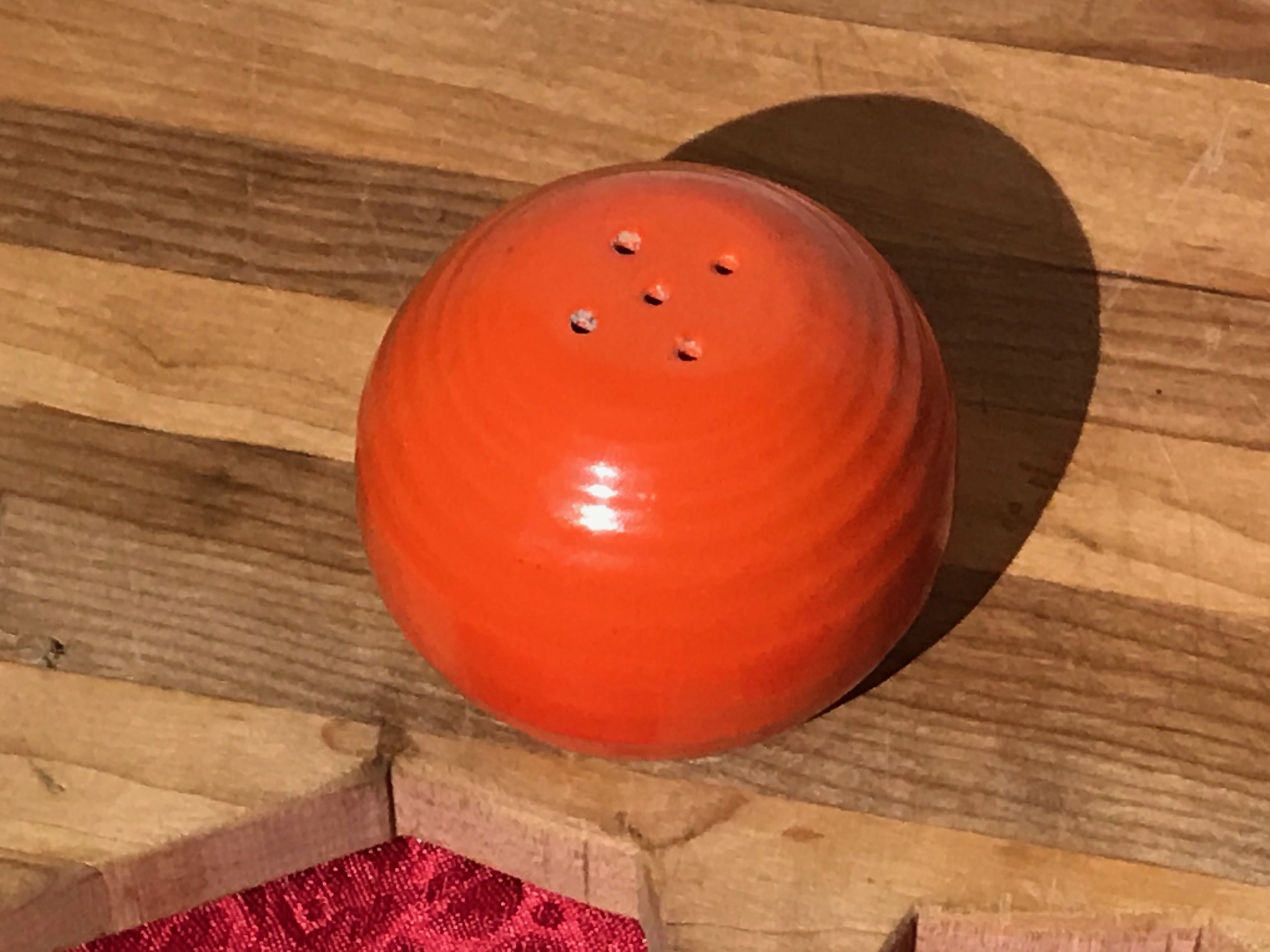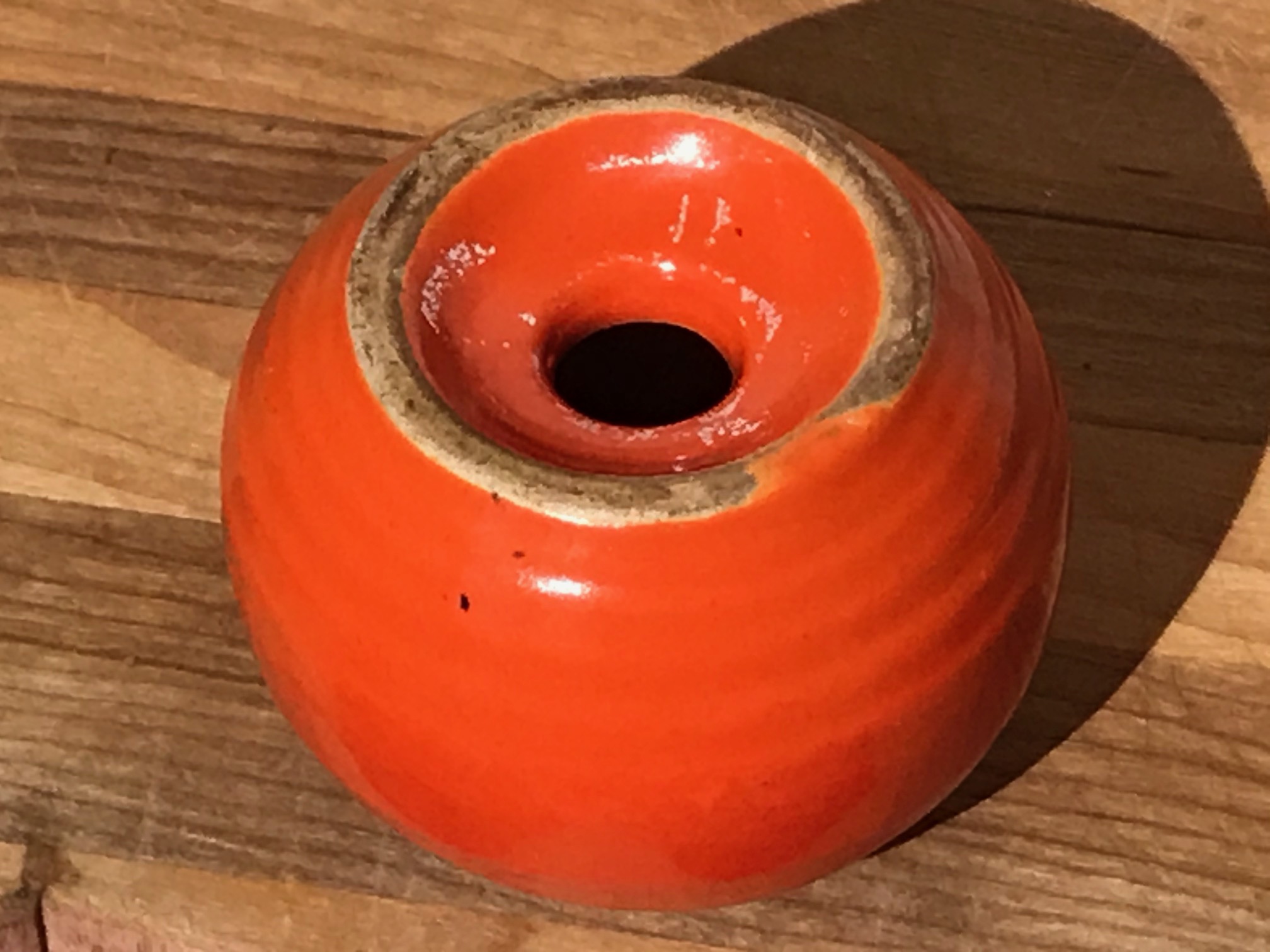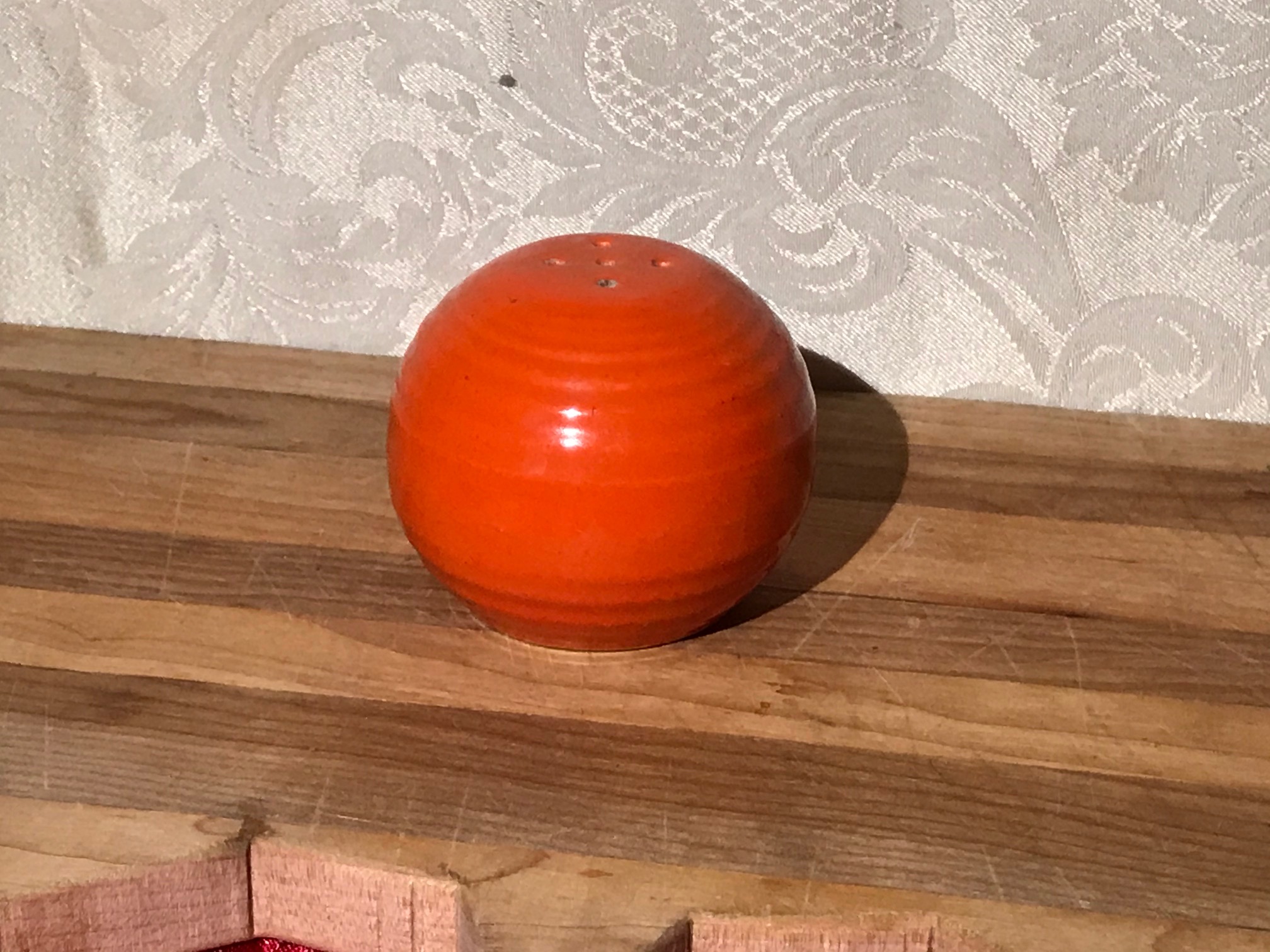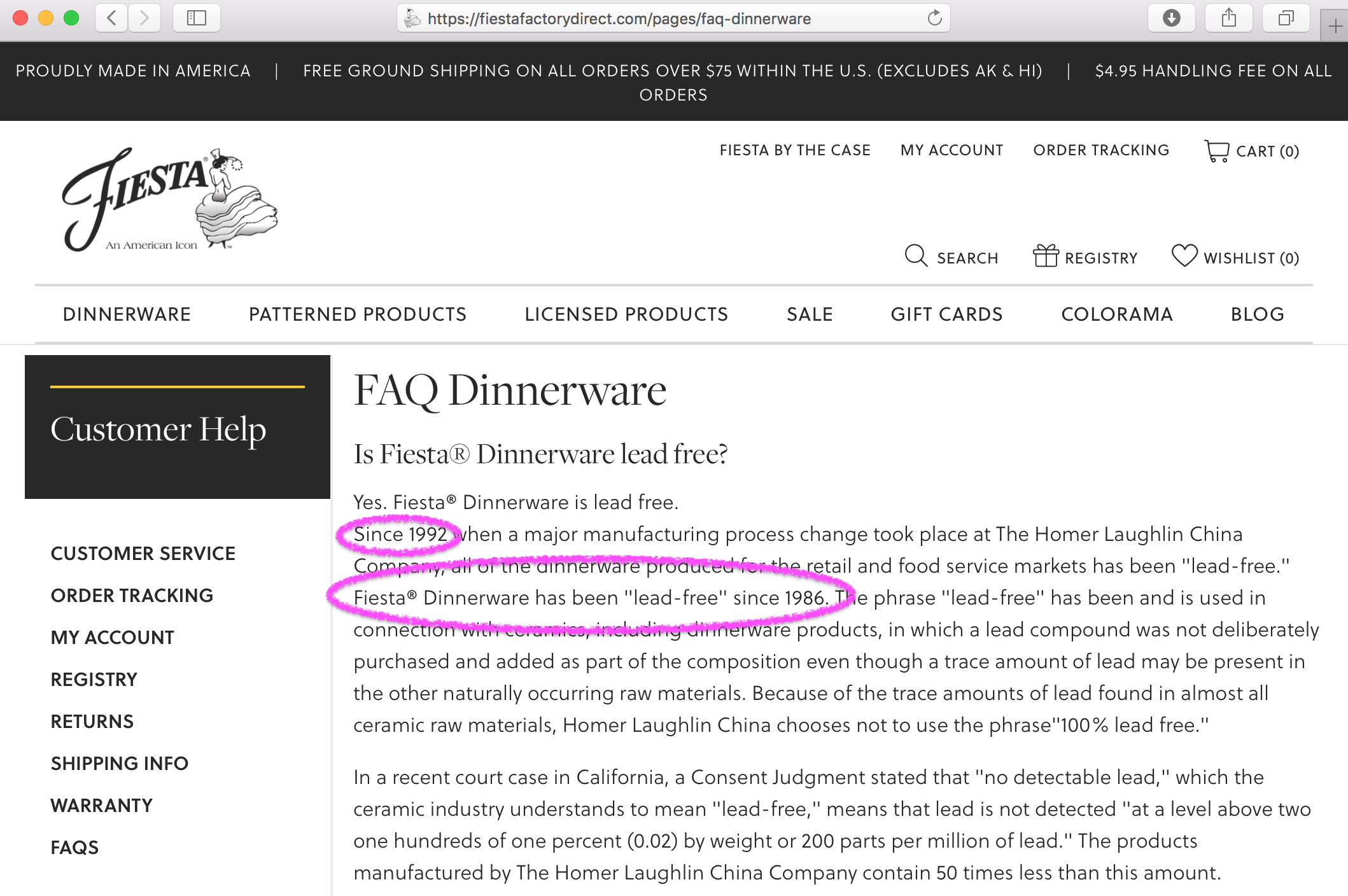Vintage orange ceramic Fiestaware-style salt shaker: 497,000 ppm Lead. Yes, about 50% Lead! 90 ppm is unsafe for kids.
 When tested with an XRF instrument, the orange glaze of the vintage Fiestaware-style ceramic salt shaker pictured here had the following readings:
When tested with an XRF instrument, the orange glaze of the vintage Fiestaware-style ceramic salt shaker pictured here had the following readings:
- Lead (Pb): 497,000 +/- 66,000
- Barium (Ba): 1,299 +/- 594 ppm
- Bromine (Br): 446 +/- 123
- Iron (Fe): 2,153 +/- 731 ppm
- Palladium (Pd): 679 +/- 178 ppm
- Molybdenum (Mo): 13,700 +/- 2,700 ppm
- Nb: 10,500 +/- 1,700 ppm
What is “vintage”?
For those new to the world of vintage and antique items, in collectors’ circles, “vintage” is commonly understood to refer to an item that is more than 20-25 years old. So – odd as it may seem, as of today [January 31, 2020], anything from 2000 or thereabouts [and, of course, anything from the several decades preceding] would generally be considered “vintage”. The term “antique” is formally reserved for items at least 100 years old.
Since Fiesta states on their website that they stopped using Lead (as an intentional ingredient) in their products as of 1992, and since 1992 was 28 years ago as of the moment of publishing this post – for the purpose of Fiestaware (specifically in relation to the conversation about Lead), we’re going to use the term “vintage” to mean “1992 or earlier.” This would also likely be true for knock offs or copies from that era.
I have no way to know the exact age or year of manufacture for this particular piece — as it is not marked in any way that would indicate the year of manufacture (to someone who isn’t an avid collector of these products); if you have some insight as to the potential year of manufacture for this piece, please do let me know.*
Some background on Fiesta and heavy metal toxicants…
For context (in spite of the unknown brand of this particular piece) I do have some Fiesta company documents that discuss their historic use of toxic heavy metals (shared with me by a reader who had an e-mail exchange with Fiesta), and I will be publishing those soon [and will link it here when it is up – so stand by for that].
In the meantime, their website actually claims two different dates for their cessation of using lead — both “1986″ and “1992″. [Here’s the page that currently lists both 1992 and 1986 as the year they went “Lead Free” officially. (see image below too!)]
Continue reading below the image:
Again – 1992 was, at this moment, 28 years ago – so that does put the Lead-glazed pieces officially in the era of “vintage”. However, to be clear, I have found trace Lead even in brand-new/modern pieces that I have tested from this company [I have also found modern pieces from Fiesta with traces of Arsenic and Cadmium.] To see some examples of “modern” Fiestaware that I have tested, click here.
What about the pieces marked “Lead-Free” on the bottom?
Are they truly Lead-free?
I have actually tested some of the newer Fiesta pieces marked “Lead Free” and found Lead in them (albeit at “trace” levels – usually below 100 ppm). However, since I first made this information public – probably 6 or 7 years ago, since the company became aware of my findings of Lead [via high-precision XRF testing] in their “Lead-free” pieces – I believe they stopped stamping the bottoms of their pieces with the words “Lead Free”, as the currently-manufactured items don’t seem to have that imprint on the bottom. They also have a public statement that essentially attempts to denounce the validity of XRF technology (!), and in their literature they claim a novel definition of “Lead-free” [they just made up how they can define words, lol!]
Wait.
What?
They claim a unique definition for the words “Lead-Free?”
Yep! [That’s where they really start to bug me!] Specifically, their website contains the astonishing doublespeak:
“The phrase “lead-free” has been and is used in connection with ceramics, including dinnerware products, in which a lead compound was not deliberately purchased and added as part of the composition even though a trace amount of lead may be present in the other naturally occurring raw materials. Because of the trace amounts of lead found in almost all ceramic raw materials, Homer Laughlin China chooses not to use the phrase”100% lead free.”
In a recent court case in California, a Consent Judgment stated that “no detectable lead,” which the ceramic industry understands to mean “lead-free,” means that lead is not detected “at a level above two one hundreds of one percent (0.02) by weight or 200 parts per million of lead.” The products manufactured by The Homer Laughlin China Company contain 50 times less than this amount.”
Nope. You guys made up this definition of “Lead Free”! As it happens, my mother was a potter…
Ceramics are only “Lead-free” if they are actually Lead-free! If they test positive for Lead using ANY methodology they are – in fact – NOT Lead-free. This language above is clearly Homer Laughlin trying to use some after-the-fact doublespeak to justify the fact that many of their dishes that were marked “Lead Free” on the bottom were not actually Lead-free. [Also that “50 times less” statement is clearly B.S. as I have detected levels far above “50 times less” than 200 ppm in new Fiesta pieces. What does “50 times less” mean anyway? What is “50 times less” than 200 ppm? I’m not quite sure what they mean by that! Lol.]
What years of Fiesta are the highest Lead?
As with many other brands of dishware, it is also safe to assume that for each decade we go back (before the year they declared themselves to be “Lead-free” in 1992) it is likely that the Lead level potentially increases significantly with the period (as well as there being variations with the colors.) I have thus seen Lead levels with these vintage pieces from this brand in the range of 60,000 ppm to 600,000 ppm Lead and – if this company is like other companies – the 600,000 ppm Lead is likely from the first part of the 20th century and the Lead levels likely get lower as we approach 1992.
Accordingly, for the orange salt shaker in question in this post, I will take an educated guess that it may be likely from c. 1950s to 1970s; but – while, at this point I may be a bit of an expert in dating consumer goods by their color and style – I am by no means an expert on the history of Fiesta’s production specifically, so would be appreciative of any additional input. [*Update: One reader just commented on Facebook that she got these as a gift in the 1980s.]
How much Lead is “too much” Lead?
The amount of Lead that is considered unsafe and illegal in a modern / newly-manufactured item made and sold as “intended for use by children” today is anything 90 ppm Lead or higher in the paint / glaze or coating, and anything 100 ppm Lead or higher in the substrate. Dishes and tableware are not covered by this regulatory standard, although it is my opinion that they should be — because children also use dishes! Needless to say, this is a very high amount of Lead, especially for something intended for food-use purposes (and bound to be handled during a meal).
Some additional reading:
- To read more about the concern for Lead in pottery and dishware, click here.
- To see more Fiesta items that I have tested, click here.
- To read more about the type of testing I do, click here.
- To see more salt and pepper shakers that I have tested, click here.
As always, please let me know if you have any questions.
Thank you for reading and for sharing my posts.
Tamara Rubin
#LeadSafeMama


Never Miss an Important Article Again!
Join our Email List




And I thought that orange Fiestaware was only dangerous because it had uranium in the glaze..
These last two years I have purchased some turquoise and white ceramic Fiestaware plates, saucers, and coffee mugs. Do I need to be concerned? Sure seems so! If you don’t have current info on can I send pay to have your text for me? If so, what is the cost?
Thanks for all that you do to help keep us all safe from toxic cookwares, etc.
Carmy
Hi Carmy,
Start by sending me a photo with the back of each of your dishes. TamaraRubin@mac.com
Tamara
Hi Tamara,
The shaker pictured is not in fact Fiestaware made by the Homer Laughlin China Company.
A photo of an actual Fiesta shaker can be seen at: https://www.post86referenceguide.com/wm/ShakerCompairsonwm.png
Please contact the Fiesta Tableware Company for clarification if necessary.
Best,
Missy
You might have more credibility if the “Fiesta Shaker” was actually a Fiesta Shaker.
It is not.
I have a big collection of fiesta from the 1950 I am interested in selling alot of it, would anyone know how I could get in touch with someone who could point me in the right direction.
Thank you.
Well. In a heartbeat I would have bought and used the vintage Fiesta ware 20 years ago, but not now. I for one stupidly collected the cheaper Vernon Kilns souvenir plates and ate off of them for a really long time. Cutesy magazines such as Cottage Living advised using such plates as dinnerware as “Fiesta is too expensive.” Luckily I bought Homer Laughlin sporadically since 1995. HOWEVER since reading this blog and doing lots of research I bought the home kit of Sodium Rhodizonate swabs. Yes. I now have a doctor appointment to have myself tested for lead poisoning. Here I have thought myself so clever and I am not.
Thank you for sharing this Susan.